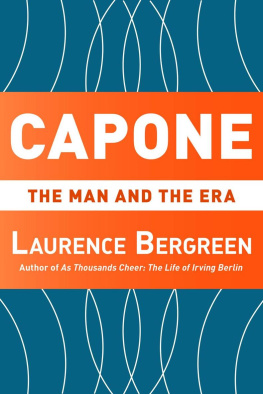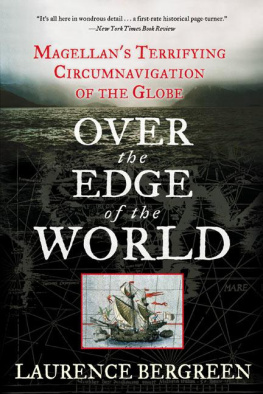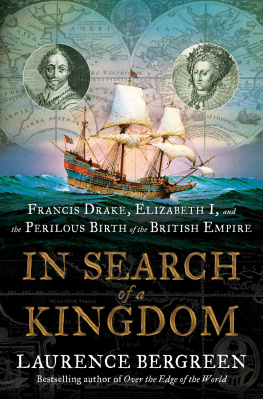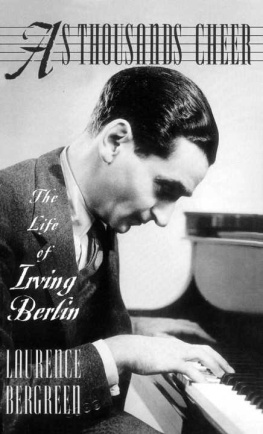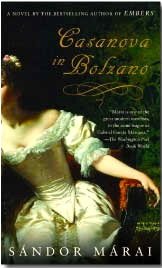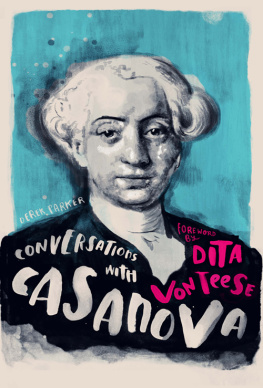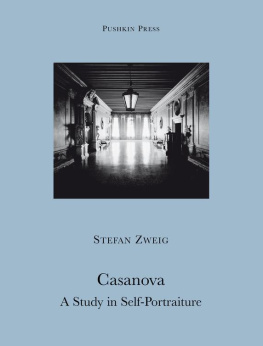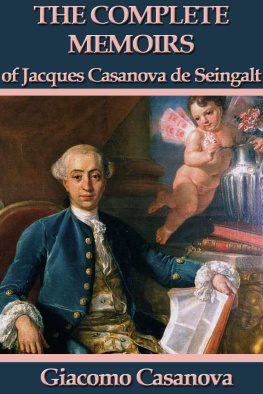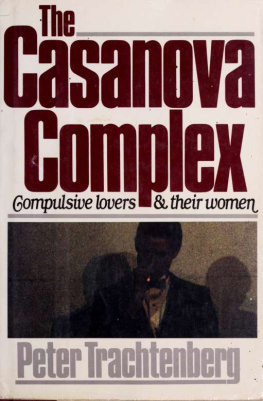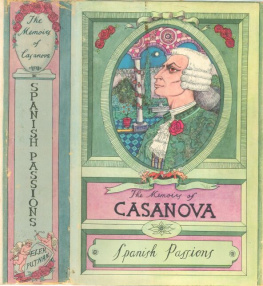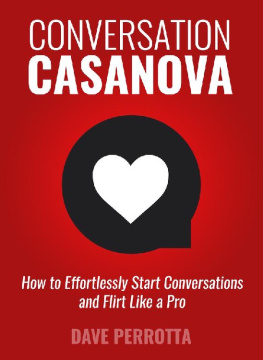To Zata, Jacqueline, and the memory of my mother
Love is three quarters curiosity.
GIACOMO CASANOVA
A LSO BY L AURENCE B ERGREEN
Columbus: The Four Voyages
Marco Polo: From Venice to Xanadu
Over the Edge of the World: Magellans Terrifying Circumnavigation of the Globe
Voyage to Mars: NASAs Search for Life Beyond Earth
Louis Armstrong: An Extravagant Life
Capone: The Man and the Era
As Thousands Cheer: The Life of Irving Berlin
James Agee: A Life
Look Now, Pay Later: The Rise of Network Broadcasting

Simon & Schuster
1230 Avenue of the Americas
New York, NY 10020
www.simonandschuster.com
Copyright 2016 by Laurence Bergreen
All rights reserved, including the right to reproduce this book or portions thereof in any form whatsoever. For information address Simon & Schuster Subsidiary Rights Department, 1230 Avenue of the Americas, New York, NY 10020.
First Simon & Schuster hardcover edition November 2016
SIMON & SCHUSTER and colophon are registered trademarks of Simon & Schuster, Inc.
For information about special discounts for bulk purchases, please contact Simon & Schuster Special Sales at 1-866-506-1949 or .
The Simon & Schuster Speakers Bureau can bring authors to your live event. For more information or to book an event contact the Simon & Schuster Speakers Bureau at 1-866-248-3049 or visit our website at www.simonspeakers.com.
Interior design by Paul Dippolito
Jacket design by Alison Forner
Jacket painting by Charles Emile Carolus-Duran (18371917). The Kiss, 1868.
Photo by Ren-Gabriel Ojeda. Rmn-Grand Palais/Art Resource, NY
Library of Congress Cataloging-in-Publication Data
Names: Bergreen, Laurence, author.
Title: Casanova : the world of a seductive genius / Laurence Bergreen.
Description: New York : Simon & Schuster, [2016] | Includes bibliographical references and index.
Identifiers: LCCN 2016019500| ISBN 9781476716497 | ISBN 1476716498 Subjects: LCSH: Casanova, Giacomo, 1725-1798. | Adventure and adventurersEuropeBiography. | EuropeHistory18th centuryBiography.
Classification: LCC D285.8.C4 B47 2016 | DDC 940.2/53092 [B] dc22 LC record available at https://lccn.loc.gov/2016019500
ISBN 978-1-4767-1649-7
ISBN 978-1-4767-1652-7 (ebook)

PREFACE
N owadays, Giacomo Casanova signifies the archetypical Latin lover, and theres a bit of Casanova in nearly everyone. But to his eighteenth-century contemporaries, the name Casanova meant something elsethe Venetian adventurer, spy, duelist, gambler, escape artist, and author of nearly one hundred novels, poems, and treatises. Jean-Jacques Rousseau, Voltaire, Catherine the Great of Russia, Benjamin Franklin, Mozart, and Lorenzo Da Pontethe librettist for Mozarts Don Giovanni and a flamboyant figure in his own rightall were friends and correspondents. To them, Giacomo Casanova personified the spirit of liberation and, more than that, libertinismunrestrained sexual pleasure. We think of Europe in the eighteenth century as the Age of Revolution or the Age of Enlightenment, but it was also the Age of Casanova, the Venetian arriviste who incarnated its passions and pleasures. And we think of Casanova as a great narcissist, yet he played many other roles in society as he sought to find a place to match his exalted yet fragile self-image. He was a genuinely outrageous figure who also happened to be a literary, psychological, and mathematical genius; a master of self-invention and self-promotion; a dedicated cardsharp, con artist, and escape artist who devised the French lottery (still in use today); and made himself into one of the first celebrities of the modern era.
Why are we still fascinated by this upstart more than two hundred years after his death? He was neither handsome, nor well-educated, nor well-born. He lacked position and power. Somehow, this impoverished son of an actress made himself into the most celebrated libertine of all time and a major literary figure of his era. His was a life lived in letters no less than in the boudoir. Casanova is legendary for personifying an archetype of the endlessly romantic, promiscuous, seductive male, yet his lesser known but equally remarkable accomplishments in mathematics and literature have received belated and only partial recognition. He broke hearts from Venice to Paris to Prague. Casanova exalted women even as he exploited them. He preferred to make love (the more romantic the better), not war, as he lived out his sexual and romantic fantasies. His desire knew no bounds; this was a man who claimed to seduce his own daughter and lured her into watching him make love to her mother. How did this reckless nobody wind up consorting with the most beautiful women and the greatest minds of his day? How did he come to write the consummate erotic memoir? How did this least-loved, cast-off child become the most celebrated lover in history?
The real-life Casanova (in a portrait by his brother Francesco) bore scant resemblance to the popular image of the fabled seducer. He was tall, at least six feet two inches, swarthy, angular, with a large forehead and prominent nose that caused him to resemble a giant goose. He generally wore a powdered wig in the fashion of the time, tight silk breeches, tricorn black hat, and a tabarro, or cloak, generally black, cascading over the shoulders, and decorated with frills. Most strikingly of all, true Venetians, and only Venetians, wore the bauta, or rigid white mask, at all times, or close to it. The nobility, men and women alike, wore masks in public and often in private. In theaters, ushers made sure that masks were in place, although patricians could remove them once the play had begun. Patricians meeting with ambassadors for official reasons had to wear the bauta, as did the envoys. The entire costume was the face that Venice presented to the world, and to itself.
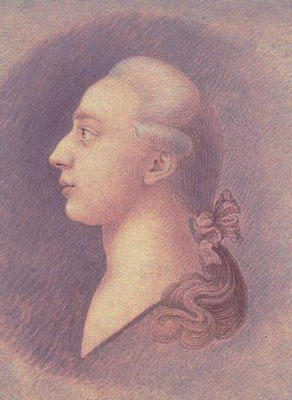
Giacomo Casanova in profile, c. 1750, by his brother Francesco Giuseppe
Women of the Republic hid behind the eerie black moretta, a velvet mask held in place with a button in the front teeth, preventing the wearer from talking. (The named derived from the word moro, Venetian for the color black.) It was also known as the servetta muta, or silent mask, and it was, if anything, even more stylized and sinister than the bauta. These costumes were not just for Carnival or for balls. With few exceptions, Venetians wore them year-round, and Venetian laws specified severe punishments for those who violated the code.
Men often found Casanova off-putting and pompous. I thought him a blockhead, wrote the biographer James Boswell after they met. He is a dandy, full of himself, blown up with vanity like a balloon and fussing about like a watermill, said the Venetian playwright Pietro Chiari, a bitter rival. But women responded to his charm, attentiveness, and agile cunning. Although he was reluctant to admit it, Casanova was not completely heterosexual; he was attracted to men disguised as women, and women disguised as men. Everything about him was ambiguous, both disconcerting and alluring.


